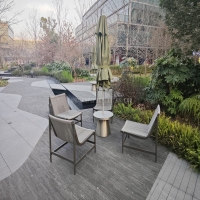Welcome to the website for landscape facilities products and knowledge.
What are the most important considerations for ensuring the table’s stability on concrete patios?
A perfectly set outdoor table on your concrete patio can be the centerpiece of relaxation and entertainment. However, an unstable, wobbling table can quickly disrupt the ambiance and become a source of frustration. Ensuring your table's stability on a hard, often imperfect concrete surface is paramount for both safety and enjoyment. The most important considerations involve addressing the foundation, the table itself, and the interface between the two.
The primary consideration is the condition of your concrete patio. Concrete is rarely perfectly level. Over time, it can settle, crack, or develop subtle slopes for water drainage. Before placing any table, assess the surface for significant unevenness. A simple way to check is to place a large, flat board on the patio and see if it rocks. Identifying these high and low spots is the first step toward a solution. For minor imperfections, the solution can be as straightforward as using adjustable table leg glides or placing shims—small, durable wedges made of plastic or rubber—under the offending leg until the wobble disappears.
The table's own design and base are equally critical. A table with a narrow or small footprint is inherently less stable than one with a broad, sturdy base. When selecting a patio table, prioritize models with robust legs or a solid central pedestal that offers a wide stance. Furthermore, the material and weight of the table play a significant role. Lightweight aluminum or plastic tables are more susceptible to being knocked over by a strong wind or a casual bump. Opting for a heavier material like cast iron, solid wood, or a stone-top table significantly increases its inertia and resistance to tipping. If your table is naturally light, consider adding weight to the base, perhaps with a sandbag or a custom-made weight plate discreetly attached.
Finally, the direct contact point between the table legs and the concrete requires attention. Bare metal or wood legs can scratch the patio surface and may slide more easily. Applying high-quality, non-slip furniture pads to the bottom of each leg is a simple yet highly effective upgrade. These pads, often made of felt or rubber, provide essential grip, protect your patio from scratches, and can also help compensate for microscopic unevenness. For a more permanent solution on a sloped patio, consider having a professional install adjustable feet that can be precisely calibrated to the exact angle of the slope, creating a perfectly level surface for your tabletop.
By systematically evaluating your patio's surface, choosing a table with a stable design and adequate weight, and utilizing simple hardware like glides and pads, you can achieve a rock-solid foundation for your outdoor dining and socializing. A stable table is not just a matter of convenience; it ensures that your focus remains on the company and the moment, not on a shaky surface.
Related search:

Recommendation
Metal structure rattan chair without armrests for single person, with woven seat and backrest.